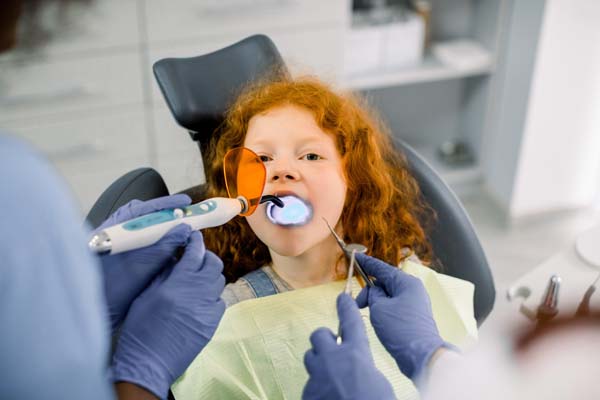The Process of Getting Dental Fillings for Kids

Dental fillings for kids can seem intimidating. Parents often fear that their child may have a bad and painful experience and then develop dental anxiety. Children (and parents) can alleviate many of these concerns by learning more about dental fillings and understanding what to expect. This review from a licensed dentist offers a general overview of the steps involved in the dental filling process for kids.
A step-by-step guide to dental fillings for kids
The dental fillings for kids process involves the dentist making a diagnosis through dental X-rays and an oral examination; preparing, numbing, and cleaning the tooth; and finally, filing the tooth with the chosen filling material. The material is then hardened with a special dental curing light. Let us take a closer look at each step in the dental filling process for kids.
Step 1: Doing the oral examination and taking dental X-rays
Diagnosing the number and severity of cavities is the first step in the dental filling process. In doing so, the dentist or hygienist may take dental X-rays and perform a painless oral examination. These provide the staff with the information necessary to prepare for the filling procedure.
Step 2: Numbing the affected area(s)
The dentist will then numb the tooth (or teeth) in preparation for the procedure. This helps ensure a painless experience for the patient. In most cases, the dentist uses a topical numbing gel. The child should feel little to nothing in the affected area after the gel is applied, and the effects should dissipate soon after the procedure. In some cases, a local anesthetic via an injection is used.
Step 3: Cleaning the decayed portion of the tooth (or teeth)
After the tooth is prepared and the affected area is numbed adequately, the dentist begins cleaning the decayed portion of the tooth (the cavity). This involves the use of dental instruments (e.g., dental scalpels and drills). The patient may hear noises from certain dental tools, but they should not feel much (if any) discomfort. The cavity is then thoroughly cleaned and disinfected.
Step 4: Filling the tooth (or teeth) with the chosen filling material
Once the tooth decay is removed and the cavity is cleaned and disinfected, the dentist fills the tooth. The material depends upon the tooth's location and the patient’s preference. For instance, a molar requires a strong material, such as metal alloy, but a tooth-colored material, such as amalgam or ceramic, may be used for a more visible front tooth.
Step 5: Hardening the filling material with a curing light
The dentist then hardens the filling material with a special dental light (curing light). The child may feel a warm sensation when the light is placed over the filling material, but it should not cause any discomfort. The light helps ensure that the filling material is properly bonded to the tooth so it will last until the tooth falls out naturally. If it is a permanent tooth, the filling material should last for at least five to 10 years in most cases.
Step 6: Rinsing the mouth
The dentist then rinses the mouth to help the patient feel refreshed after the procedure. The mouth may remain numb for up to 12 hours after the dental filling procedure. Complications are rare, but the parent should contact the dentist if discomfort persists for more than 24 hours after the dental filling.
Step 7: Following aftercare instructions
The dentist will provide aftercare instructions, which include ways to help the child maintain good oral hygiene until the next visit. Keep in mind that routine check-ups and cleaning visits are recommended every four to six months.
Specifically, the aftercare instructions may include brushing tips and techniques, dietary recommendations (e.g., limiting the consumption of sugar and other carbs), and tips on how to prevent dental trauma, which is especially important if the child plays sports or participates in other physical activities (e.g., plays on the trampoline often).
Our kid-friendly dentist offers dental fillings for kids
Are you searching for a kid-friendly dentist in your area? If so, visit us today. We pride ourselves in providing a kid-friendly environment and helping to ensure that kids are comfortable and confident every time that they come to see us. We also offer dental fillings for kids and work hard to ensure the most painless process possible. If you contact us, we would be happy to answer any of your questions and address any of your concerns.
Request an appointment here: https://www.hvkidsmiles.com or call Hudson Valley Pediatric Dentistry at (845) 363-4177 for an appointment in our Middletown office.
Check out what others are saying about our services on Yelp: Read our Yelp reviews.
Recent Posts
Dental sealants are plastic coatings that protect teeth surfaces from decay. Since children are highly susceptible to cavities, pediatric dentists often recommend sealants to protect molars and premolars upon eruption. If you are considering this preventive treatment for your child, read on to learn more about the pros and cons of dental sealants.Tooth decay is…
Dental sealants safeguard the teeth against tooth decay by forming a barrier between bacterial plaque and the tooth enamel. The many tiny grooves on the surfaces of the back teeth may catch food particles. Since routine brushing cannot entirely remove them, they often stay there for an extended period. Cavities develop as a result of…
If a cavity develops and worsens, it could lead to the risk of a dental emergency due to an infection or severe discomfort. Dental sealants significantly reduce the risk of a dental emergency by helping to prevent cavities in vulnerable areas of teeth. Read on to learn how dental sealants can prevent a dental emergency…
Pediatric dentistry is a field of dental care that helps foster healthy oral habits in children and adolescents that can last a lifetime. By introducing young patients to regular dental care early on, these dental professionals and the patient's parents can set the foundation for strong, healthy teeth and gums. Here are five ways pediatric…


